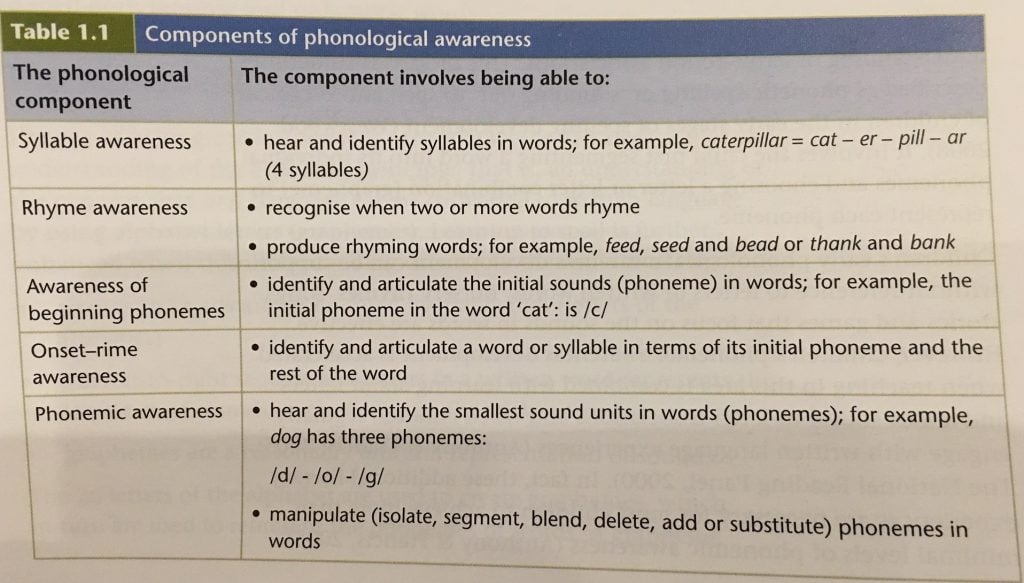Notes:

Spelling is not learned by rote or by immersion in writing and reading experiences.
Spelling is learned through:
- the strategic use of knowledge about
- Phonology – sound structure
- Orthography – written symbols to represent spoken language
- Morphology – smallest parts of words that carry meaning
- Etymology – origin of words
- visual activity – memory
- metalanguage
- phoneme
- syllable
- affixes
- morpheme – units of meaning, base, root words, prefixes, suffixes
- spelling system
- generalisations
- integration with the teaching of phonological awareness, phonics, word study, vocabulary, writing and reading.
Components of Phonological Awareness:

A Comprehensive Model of Spelling for Educators

Motivation and willingness to engage is influenced by quality of the learning environment, characterised by:
- meaningful
- ‘real life’ significance
- reasonable level of challenge
Instruction needs to:
- be related to writing and it’s role in effective communication.
- involve students in group work
- involve solving word problems
- build a community of spellers who know how to research and use words for authentic purposes
- see the teacher taking an important role in modelling and inspiring a passion about words and their value as tools for communication
Differentiation will be needed to meet the students’ range of needs.
“It would be a waste of everybody’s time if they were all expected to learn the same words, strategies and skills.”
To differentiate consider:
- readiness
- interest
- learning profile
To assess readiness the Words Their Way test can be used as a pre-assessment.
Content
- high frequency word lists
- words of interest to student
- words that the teacher has noticed the student trying to spell in writing
- words that contain features that the students needs to practise
- words from topics that are being covered across the curriculum
“Having students work through a commercial workbook, at their own pace, does not constitute differentiated teaching.”
7 Goals for Differentiation in the Classroom – Heacox 2002
- Develop challenging and engaging tasks for each learner.
- Develop instructional activities based on essential topics and concepts, processes and skills, and differentiated ways of displaying learning.
- Provide flexible approaches to content instruction and products.
- Respond to students’ readiness, instructional needs, interests, and learning preferences.
- Provide opportunities for students to work in various instructional formats.
- Meet curriculum standards and requirements for each learner.
- Establish learner-responsive, teacher-facilitated classrooms.
Recommended sequence for teaching sound-letter correspondence.

Spelling Sequence 1

Spelling Sequence 2
Sources of Knowledge
Phonological Knowledge
- syllables
- rhyme
- onset-rhyme
- phonemes
- phonemic manipulation
- word pronumciation
- segmenting words into syllables, phonemes or morphemes
Orthographic Knowledge
- sound-letter relationship
- common spelling patterns/ letter sequences
- rules for positioning of letter in words
Morphological Knowledge
- free and bound morphemes
- root and base words
- prefixes and suffixes; included inflected endings
- word derivations
- rules and generalisations regarding adding suffixes
- compound words
- homonyms
Suggested sequence for introducing morphemes Table 4.4 page 76
Visual perception problems
http://www.thevisiontherapycenter.com/discovering-vision-therapy/bid/81695/Spelling-Difficulties-in-Students-Caused-by-Vision-Problems
Word Consciousness
- interested in words
- being aware of words and their parts
- curious and motivated to learn
Spelling is a thinking process not a rote learning task.
Spelling Strategy posters:
- Sound it out
- Does it look right?
- Spell by meaning
- Consulting an authority
- Analogy
- Spell by rule
- Mnemonics
Technology based interventions:
- Phonics Alive – Advanced Software
- Clicker Phonics
- Fast Forward – (Fairly costly but developed by neuroscientists)
- Aerobics by Houghton Mifflin Harcourt
- Wordshark 5 by White Space Ltd
- Apps
- Hearbuilder
- Prof’s Phonics 1
- Alpha Writer
- Plickers – using a game called ‘You can join my game’
Use data about where your students are at to determine needs and address these.
Assessment is an important tool to do this.
Explicit teaching of
- Language
- phoneme
- syllable
- morpheme
- suffix
- affix
- baseword
- prefix
- rootword
- compound
- homophone
- homonym
- Strategies
- Phonological Knowledge
- Orthographic Knowledge
- Morphological Knowledge
- Etymological Knowledge
Summary:
Characteristics of an effective Spelling Program:
- Regular assessment – data analysis indicating growth
- Differentiated practices
- word lists
- choices in activities/ ways of working depending on needs and interests
- Goal setting and regular monitoring with high student involvement in these processes
- Metalanguage developed
- Students increasingly developing vocabulary to describe strategies and thinking processes used
- Learning applied to writing
- Sense of fun, wonder, challenge experienced
- Games, challenges as a class
- Curriculum standards addressed and achieved
- students increasingly able to articulate their learning, explaining patterns and generalisations and appropriately applying these
- Evidence shows development – what students say, write, do and make reflected on skills/ knowledge continuum (may not be linear)
- Intervention strategies implemented for cohorts/ individuals as necessary with support of SSO, parent, peer tutor, regular time with the teacher – tied to goals which are time bound and reviewed to measure effectiveness of processes used.
- Further assessment sought/ referred if intervention not successful
- technological tools could be useful (Phonics Alive, Apps, Text to speech (coping strategy)
- Students use their knowledge and skills strategically to spell increasingly proficiently
- phonological knowledge
- orthographical knowledge
- morphological knowledge
- etymological knowledge
- apply strategies for how to spell unknown words
- sound
- sight
- meaning
- rules
- mnemonics
- authority








